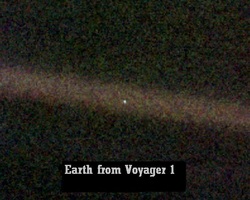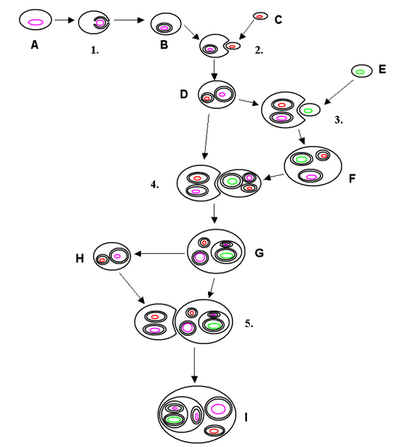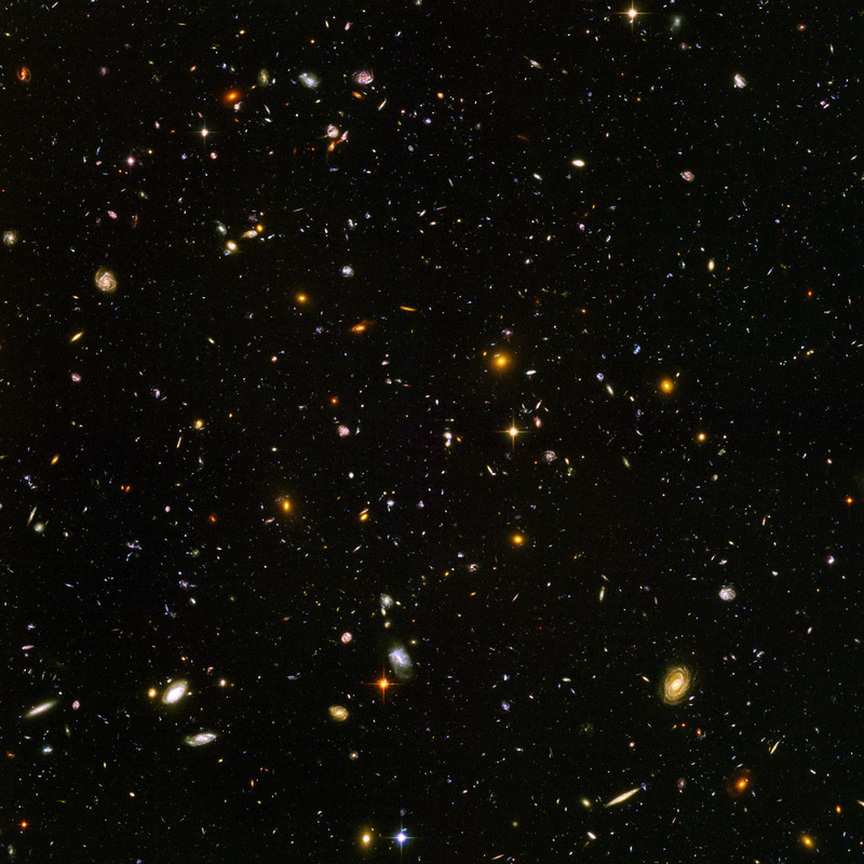
See that pale blue dot in the center of the image? That's Earth taken by the Voyager 1 space probe over 4 Billion miles from Earth. I think it's beautiful It shows us in our fragility and puts all our troubles, history and daily lives into perspective. A small dot on the western arm of the Milky Way orbiting around an ordinary singular yellow star with no other distinguishing features other than it contains life and it's our home.
Voyager 1 is at the far edge of our solar system on the boundaries of Inter Stella space, the space between the stars, a frontier which no man made object has ever travelled before. Scientists ask voyager to take this one last image of home, the kind you take before moving on with your life to green fields and pastures new. It's not heading anywhere in particular in about 40,000 years it will pass within touching distance of a star with the punchy name AC+79 3888 Such is the vastness of the Infinity of space. Our own neighbour in the solar system, Proxima Centuri lies 4.1 light years away from earth. A light year is such a vast measurement of distance its incomprehensible to even think how far that is away.
Scientist generally believe the universe was created 15 billion years ago, maybe with the big bang nobody is quite sure as the one thing we can't see is what caused the universe in the first place. What we do know is that everything you see in the universe was once contained in something so infinity small that an atom would be the size of the universe is now in comparison. In the 1st seconds after the big bang the universe experienced hyper inflation. The best way to imagine this is lighting a firework for a couple of seconds it fizzles then all the sudden it seems to fill the whole sky. This early universe was hot, extremely hot, hot enough to fuse together the smallest particles into atoms and the first matter was born. Everything you see around you wherever you look contains billions and billions of atoms, every single one of which started in the same place 15 billion years ago.
We now live in a universe that is full of bright objects. On a clear night you can see thousands of stars with the naked eye. These stars occupy merely a small nearby part of the Milky Way galaxy; telescopes reveal a much vaster realm that shines with the light from billions of galaxies. According to our current understanding of cosmology, however, the universe was featureless and dark for a long stretch of its early history. The first stars did not appear until perhaps 100 million years after the big bang.
The first stars were quite massive many times larger than the sun and many times as luminous and that their formation was an event that fundamentally changed the universe and its subsequent evolution. These stars altered the dynamics of the cosmos by heating and ionizing the surrounding gases. The earliest stars also produced and dispersed the first heavy elements, paving the way for the eventual formation of solar systems like our own. And the collapse of some of the first stars may have seeded the growth of supermassive black holes that formed in the hearts of galaxies In short, the earliest stars made possible the emergence of the universe that we see today, everything from galaxies and solar systems to planets and people.
Voyager 1 is at the far edge of our solar system on the boundaries of Inter Stella space, the space between the stars, a frontier which no man made object has ever travelled before. Scientists ask voyager to take this one last image of home, the kind you take before moving on with your life to green fields and pastures new. It's not heading anywhere in particular in about 40,000 years it will pass within touching distance of a star with the punchy name AC+79 3888 Such is the vastness of the Infinity of space. Our own neighbour in the solar system, Proxima Centuri lies 4.1 light years away from earth. A light year is such a vast measurement of distance its incomprehensible to even think how far that is away.
Scientist generally believe the universe was created 15 billion years ago, maybe with the big bang nobody is quite sure as the one thing we can't see is what caused the universe in the first place. What we do know is that everything you see in the universe was once contained in something so infinity small that an atom would be the size of the universe is now in comparison. In the 1st seconds after the big bang the universe experienced hyper inflation. The best way to imagine this is lighting a firework for a couple of seconds it fizzles then all the sudden it seems to fill the whole sky. This early universe was hot, extremely hot, hot enough to fuse together the smallest particles into atoms and the first matter was born. Everything you see around you wherever you look contains billions and billions of atoms, every single one of which started in the same place 15 billion years ago.
We now live in a universe that is full of bright objects. On a clear night you can see thousands of stars with the naked eye. These stars occupy merely a small nearby part of the Milky Way galaxy; telescopes reveal a much vaster realm that shines with the light from billions of galaxies. According to our current understanding of cosmology, however, the universe was featureless and dark for a long stretch of its early history. The first stars did not appear until perhaps 100 million years after the big bang.
The first stars were quite massive many times larger than the sun and many times as luminous and that their formation was an event that fundamentally changed the universe and its subsequent evolution. These stars altered the dynamics of the cosmos by heating and ionizing the surrounding gases. The earliest stars also produced and dispersed the first heavy elements, paving the way for the eventual formation of solar systems like our own. And the collapse of some of the first stars may have seeded the growth of supermassive black holes that formed in the hearts of galaxies In short, the earliest stars made possible the emergence of the universe that we see today, everything from galaxies and solar systems to planets and people.
THE FIRST GALAXY'S
Around 900 million years after the big bang Galaxy's started to form. In the picture above nearly every single point of light you see is a galaxy. Hubble focused its telescope on a rather uninteresting piece of dark sky, unobstructed by any stars in the milky way and left the shutter open for 10 days what you see above is the result of that shot. Every single one of those galaxy's contain billions of stars, each star with the possibility of having its own pale blue dot orbiting it's star, with its own people reading a blog, looking up into the skys and asking the very same questions as us. If you scroll to the bottom of the picture (which you probably have) look right at the bottom middle, move your eyes up, you'll see what looks like a bright orange star. Now go right, between the orange star like structure and the yellow spiral galaxy to it's right you will see a very very small red dot. if you were not looking for it you would miss it. its slightly above the line between the two objects almost in the middle of the two. This tiny tiny red dot is one of the oldest galaxy's we've so far discovered. when it's light first set off in our direction our sun hadn't even been born yet. How do we know this? Well it's due to one of the interesting properties of light. We've all seen a rainbow, we all kind of know how it works, the sun hits the rain at a certain angle and depending on how the rain drops bends the light depends on the colours we see. red light has to travel the furthest and is refracted the most. the blue/indigo light you see the least. Everything in the Universe is expanding objects are getting further away from each other. so as galaxy's move further away their light goes redder and redder. This is known as the red shift. So at one time to a Hubble telescope millions of years ago that small red dot would have been as vibrant as the yellow spiral galaxy is today and in billions of years that yellow galaxy will itself become a small red dot. Conversely new stars when we see them are usually bright blue in colour.
Galaxy's were formed by the deaths of the super massive stars. these old stars created clouds of gas which swirled around their dead embers like flies around a carcass these clouds contained elements that we know now. Hydrogen, Helium, Lithium, Boron, Beryllium all the elements of the periodic table created by the supernova of a dying star. New stars were born by gravity pulling together these small particles until eventually they were so large ignition happens and another singular light goes on in the universe. The remainder of this gas swirls around the sun being heated by the new heat radiating from it's surface forming the planets and the solar system we live in ourselves.
The Solar System formed from the gravitational collapse of a giant gas cloud 4.568 billion years ago.This initial cloud was likely several light-years across and probably birthed several stars other than our own. The Solar System has evolved considerably since its initial formation. Many moons have formed from circling discs of gas and dust around their parent planets, while other moons are believed to have formed independently and later been captured by their planets. Still others, as the Earth's Moon, may be the result of giant collisions. Collisions between bodies have occurred continually up to the present day and have been central to the evolution of the Solar System.
Galaxy's were formed by the deaths of the super massive stars. these old stars created clouds of gas which swirled around their dead embers like flies around a carcass these clouds contained elements that we know now. Hydrogen, Helium, Lithium, Boron, Beryllium all the elements of the periodic table created by the supernova of a dying star. New stars were born by gravity pulling together these small particles until eventually they were so large ignition happens and another singular light goes on in the universe. The remainder of this gas swirls around the sun being heated by the new heat radiating from it's surface forming the planets and the solar system we live in ourselves.
The Solar System formed from the gravitational collapse of a giant gas cloud 4.568 billion years ago.This initial cloud was likely several light-years across and probably birthed several stars other than our own. The Solar System has evolved considerably since its initial formation. Many moons have formed from circling discs of gas and dust around their parent planets, while other moons are believed to have formed independently and later been captured by their planets. Still others, as the Earth's Moon, may be the result of giant collisions. Collisions between bodies have occurred continually up to the present day and have been central to the evolution of the Solar System.

az
At the end of the planetary formation epoch the inner Solar System was populated by 50–100 Moon- to Mars-sized planetary embryos. Further growth was possible only because these bodies collided and merged, which took less than 100 million years. These objects would have gravitationally interacted with one another, tugging at each other's orbits until they collided, growing larger until the four inner planets we know today took shape.
Around 4 billion years ago the earth started to solidify, Ice comets and objects the size of Pluto bombarded the planet in a phase called the late heavy bombardment this is where most our water came from, and most the extra-terrestrial water we now find on other planets in our solar system. These oceans were bombarded with asteroids probably starting and evaporating life numerous times in the next million years eventually the bombardment stopped. Life started small bacterial strains started to emerge. where did life come from? The same place everything else came from, the death of stars, carbon is our main component. its in every living thing and its in the make up of every star, the primordial earth was vastly different to the one you see now. more acidic, more oxygenated and more adapt for life forming. Over the next billion years life never really got very complex until the Cambrian explosion 530 million years ago skeletons start to appear in fossils for the 1st time and many more animals such as molluscs and anthropoids started to appear
Around 4 billion years ago the earth started to solidify, Ice comets and objects the size of Pluto bombarded the planet in a phase called the late heavy bombardment this is where most our water came from, and most the extra-terrestrial water we now find on other planets in our solar system. These oceans were bombarded with asteroids probably starting and evaporating life numerous times in the next million years eventually the bombardment stopped. Life started small bacterial strains started to emerge. where did life come from? The same place everything else came from, the death of stars, carbon is our main component. its in every living thing and its in the make up of every star, the primordial earth was vastly different to the one you see now. more acidic, more oxygenated and more adapt for life forming. Over the next billion years life never really got very complex until the Cambrian explosion 530 million years ago skeletons start to appear in fossils for the 1st time and many more animals such as molluscs and anthropoids started to appear

This picture is just an idea of how Life could evolve from the very first objects to the Cambrian explosion. three very simple forms of life come together to form the first cells and eventually the first organisms. By the end of the Cambrian period the first fish had started to appear, and more importantly the first plants . Plants need photosynthesis to survive and they give off oxygen as part of that process. The oxygen increase lead to the formation of the Ozone layer, and eventually an end to harmful ultra-violet radiation, this meant for the first time life could survive outside of the oceans. Until this time our earth resembled the surface of Mars. A barren wasteland with no living thing on it. A hostile place. the first tetrapods evolved from fish. It is thought that perhaps fins evolved to become limbs which allowed the first tetrapods to lift their heads out of the water to breathe air. This would allow them to live in oxygen-poor water or pursue small prey in shallow water. Plants evolved seeds, which dramatically accelerated their spread on land, around this time. Some 20 million years later the egg evolved (yes the Egg came before the chicken, I know highly controversial here) which could be laid on land, giving a survival advantage to tetrapod embryos. This resulted in the first amphibians. another 40 million years and the first mammals started to crawl around.
HUMANS
A small African ape living around six Million years ago was the last animal whose descendants would include both modern humans and their closest relatives, the bonobo and chimpanzees. Brain size increased rapidly, and by 2 million years ago, the first animals classified in the genus homo had appeared. Of course, the line between different species or even genera is somewhat arbitrary as organisms continuously change over generations. Around the same time, the other branch split into the ancestors of the common chimpanzee and the ancestors of the bonobo as evolution continued simultaneously in all life forms. Modern humans ( are believed to have originated somewhere around 200,000 years ago or earlier in Africa; the oldest fossils date back to around 160,000 years ago. The rest is History....and that's a topic for another day.....
HUMANS
A small African ape living around six Million years ago was the last animal whose descendants would include both modern humans and their closest relatives, the bonobo and chimpanzees. Brain size increased rapidly, and by 2 million years ago, the first animals classified in the genus homo had appeared. Of course, the line between different species or even genera is somewhat arbitrary as organisms continuously change over generations. Around the same time, the other branch split into the ancestors of the common chimpanzee and the ancestors of the bonobo as evolution continued simultaneously in all life forms. Modern humans ( are believed to have originated somewhere around 200,000 years ago or earlier in Africa; the oldest fossils date back to around 160,000 years ago. The rest is History....and that's a topic for another day.....

 RSS Feed
RSS Feed